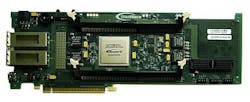FPGA-based PCI Express single-board computer for signal processing and data acquisition introduced by BittWare
CONCORD, N.H., 20 Sept. 2011. BittWare Inc. in Concord, N.H., is introducing the S5-PCIe, a PCI Express single-board computer for high-performance signal processing and data acquisition in embedded computing applications. The S5-PCIe is based on the Stratix V field-programmable gate array (FPGA) from Altera Corp. in San Jose, Calif, provides two VITA-57 FPGA Mezzanine Card (FMC) sites for additional I/O and processing, and two optional QSFP+ cages for serial I/O.The board, which will be available this fall, comes with either an Altera Stratix V GX FPGA or a Stratix V GS FPGA and as much as 32 gigabytes of DDR3 SDRAM. The S5-PCIe is optionally supported by BittWare's Anemone low-power, floating point, C-programmable FPGA co-processor, and the ATLANTiS FrameWork development and integration tool.
The board's x8 PCI Express interface provides eight SerDes lanes to the Stratix V FPGA. The BittWorks II Toolkit comes with the board to provide libraries and applications.
For more information contact BittWare online at www.bittware.com.
Related stories
-- BittWare claims new architecture puts DSP vs. FPGA debate to rest; and
